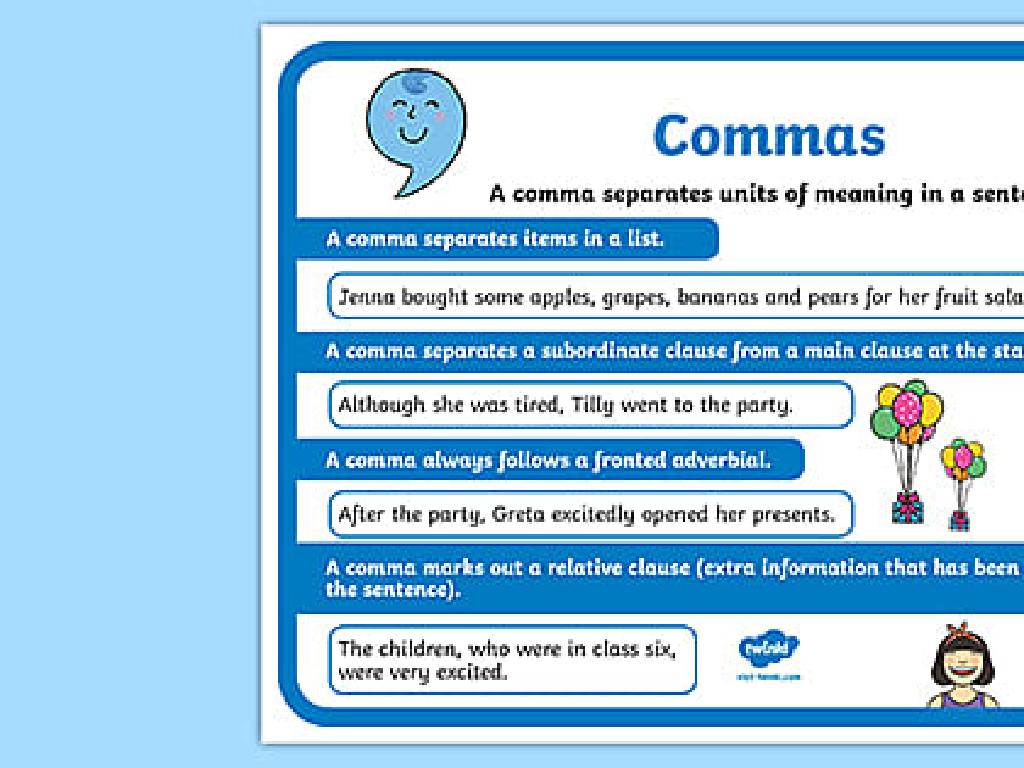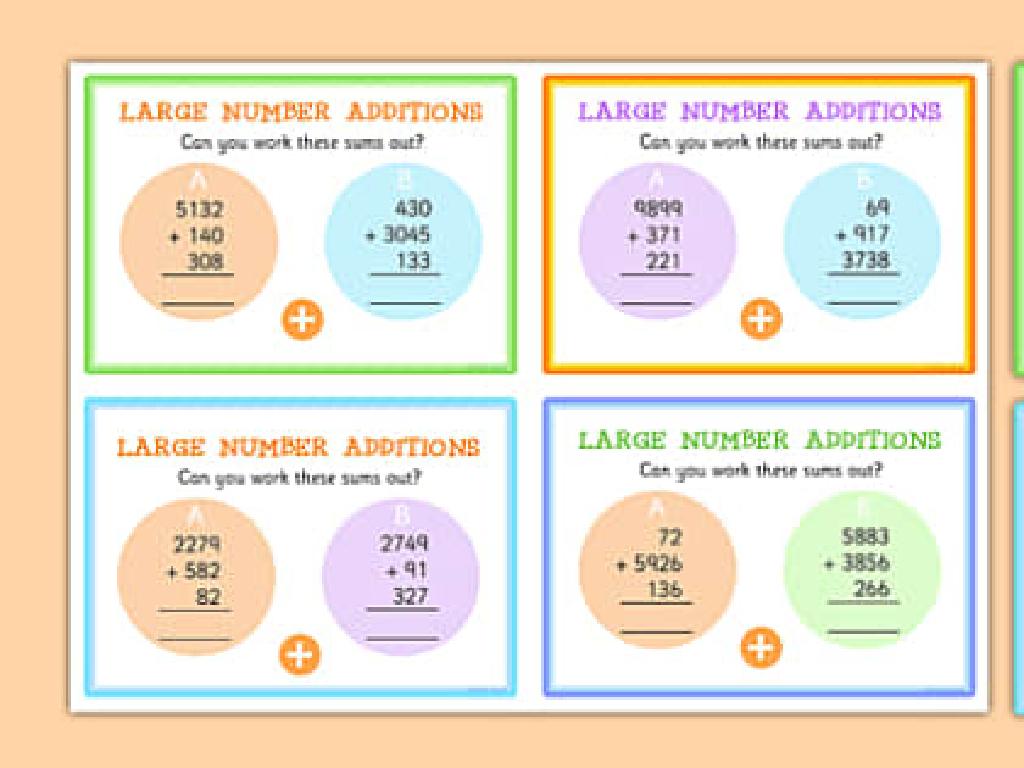Identify Earth's Land Features
Subject: Science
Grade: Third grade
Topic: Earth's Features
Please LOG IN to download the presentation. Access is available to registered users only.
View More Content
Exploring Earth’s Land Features
– Types of land on Earth
– Earth has various landforms like mountains, valleys, plains, and deserts.
– Mountains, valleys, and plains
– Mountains are high and rocky, valleys are low areas between hills, and plains are large, flat lands.
– Importance of land features
– Knowing about land helps us understand Earth’s history and where it’s safe to build homes.
– How land features affect us
– Land features can determine the weather patterns and the types of plants and animals that can live in an area.
|
This slide introduces students to the diverse land features found on Earth. Start by discussing the different types of landforms, such as mountains, valleys, and plains, and provide examples of each. Explain how these features are formed and their significance to Earth’s landscape. Emphasize the importance of understanding Earth’s surface, including how it affects where people live, the weather, and the environment. Encourage students to think about how the land features near their community impact their daily lives. This will help them appreciate the practical aspects of Earth’s geography.
Exploring Earth’s Land Features
– What are land features?
– Natural parts of Earth’s surface
– Examples: mountains, valleys
– Mountains: high, rocky; Valleys: low areas between mountains
– Examples: plains, plateaus
– Plains: flat, wide open spaces; Plateaus: flat, raised areas
– Unique features and formations
– Each has a distinct look and way it was formed
|
This slide introduces students to the concept of land features as the natural parts of the Earth’s surface. Provide visual examples of each land feature to help students identify them. Explain that mountains are high and rocky, and valleys are the low areas between mountains. Plains are vast stretches of flat land, while plateaus are flat but elevated areas. Emphasize the uniqueness of each land feature, including how they look and how they were formed. Encourage students to think about the land features near where they live or places they have visited.
Exploring Mountains: Earth’s Majestic Land Features
– Mountains are tall with steep sides
– Like a giant rocky pyramid reaching to the sky
– Formed by volcanoes or plate collisions
– When Earth’s crust moves, mountains can rise
– Mount Everest is Earth’s tallest
– 29,029 feet tall, located in the Himalayas
– Mountains affect weather and climate
|
This slide introduces students to the concept of mountains as one of Earth’s land features. Explain that mountains are much higher than the land around them, often with very steep sides, and they can be identified by their peak or summit. Discuss the formation of mountains, emphasizing the natural processes such as volcanic activity and the movement of tectonic plates. Highlight Mount Everest as an example of the tallest mountain to help students grasp the enormity of these natural structures. Also, touch on how mountains can influence local and global weather patterns as well as climate, which can be a gateway to discussing ecosystems and biodiversity in mountainous regions.
Exploring Valleys: Earth’s Land Features
– Valleys: low areas on Earth
– Valleys are like big ditches between mountains or hills.
– Formed by rivers or glaciers
– Rivers carve out valleys over time, glaciers sculpt them too.
– Varieties: wide, flat, narrow, deep
– Some valleys are broad with lots of room, others are like deep cuts.
– Valleys support diverse ecosystems
|
Valleys are important land features formed by geological processes involving rivers and glaciers. They can vary greatly in shape and size, with some being wide and flat, suitable for farming and settlements, while others are narrow and deep, often found in mountainous regions. When discussing valleys, emphasize the role of erosion and the long periods over which valleys are formed. Provide examples of famous valleys like the Grand Canyon or the Nile Valley to give students a real-world context. Encourage students to think about how valleys might affect where people choose to live and how they might use the land for agriculture or shelter.
Exploring Plains: Earth’s Land Features
– Plains are vast flat lands
– Imagine a huge, open field where you can run and play!
– Ideal for farming activities
– Many of our foods come from crops grown on plains.
– Plains have fertile soil
– ‘Fertile’ means the soil is good for plants.
– Plains exist worldwide
– From Asia’s grasslands to America’s prairies!
|
This slide introduces students to plains as one of Earth’s land features. Emphasize the characteristics of plains, such as their flatness and vastness, which make them easily recognizable. Discuss why plains are important for agriculture due to their rich and fertile soil, which is good for growing crops. Provide examples of plains from different continents to illustrate their global presence. Encourage students to think about local plains and the types of crops that might be grown there. This will help them connect the concept of plains to their everyday lives and the foods they eat.
Exploring Plateaus
– What is a plateau?
– A flat area higher than surrounding land
– How are plateaus formed?
– Formed by volcanic activity or erosion
– Plateaus vs. plains
– ‘High plains’ due to their flat tops
– Examples of plateaus
– Colorado Plateau, Deccan Plateau
|
This slide introduces the concept of plateaus to third-grade students. Begin by explaining that a plateau is like a table with flat top that stands above the nearby land. Discuss the natural processes that can lead to the formation of plateaus, such as the cooling and hardening of lava during volcanic activity or the gradual wearing away of land by wind and water, known as erosion. Highlight the difference between plateaus and plains by emphasizing the elevation aspect of plateaus. Provide real-world examples like the Colorado Plateau in the United States or the Deccan Plateau in India to help students visualize these landforms. Encourage students to think about why plateaus might be important for the environment and people living on or near them.
Create Your Own Land Features
– Become a junior geologist
– Craft land features with clay
– Use your hands to shape the Earth’s surface
– Include a mountain in your model
– A mountain is a high, uplifted area with steep slopes
– Add a valley, plain, and plateau
– Valleys are low areas between mountains, plains are large flat areas, and plateaus are flat highlands
|
This activity is designed to help students understand Earth’s land features by creating a tangible model. Provide each student with clay and guide them to mold various landforms. Explain that a mountain is a high area with steep sides, a valley is a low area often between mountains, plains are large stretches of flat land, and a plateau is like a plain but elevated higher. Encourage creativity and ensure they represent each land feature distinctly. This hands-on experience will help solidify their understanding of the different types of land features they’ve learned about. After the activity, have students present their models and explain the features they’ve created.
Class Discussion: Earth’s Land Features
– Share your model’s land features
– Reasons for choosing these features
– Impact of land features on environment
– Land features can change climates, like mountains affecting rainfall
– How they affect people’s lives
– Features like valleys may be fertile for farming, while mountains can isolate communities
|
This slide is meant to facilitate a class discussion about the land features the students have included in their models. Encourage each student to think about the land features they’ve chosen, such as mountains, valleys, rivers, or plains, and articulate why they included them in their model. Discuss how these features can influence the environment, for example, mountains can create rain shadows or rivers can support ecosystems. Also, explore how these features affect human activities and settlements, like how valleys may be used for agriculture or how coastal features can support fishing industries. This discussion will help students understand the relationship between Earth’s land features, the environment, and human life.
Exploring Earth’s Land Features: A Geologist’s Journey
– Congratulations, young geologists!
– Journey through mountains, valleys, plains, and plateaus
– These are high, low, flat, and raised areas you’ve learned about
– Earth’s features shape our geography
– They define locations and influence climate and natural resources
– Landforms play a role in ecosystems
– Habitats and biodiversity are linked to these landforms
|
Well done to all the third-grade students for learning about the different land features of our planet! Mountains, valleys, plains, and plateaus are not just fascinating to look at but also serve crucial roles in our world’s geography and ecosystems. They determine where people can live, influence weather patterns, and are home to a variety of plants and animals. Remember, the knowledge you’ve gained about Earth’s land features is just the beginning of understanding how our planet works. Keep exploring and asking questions about the world around you!






